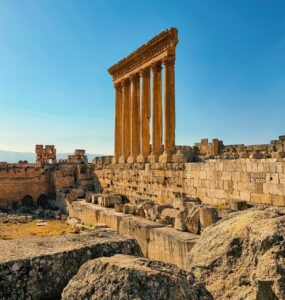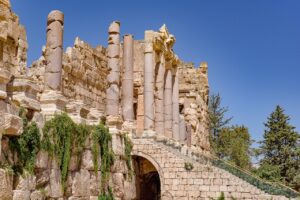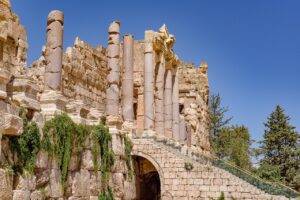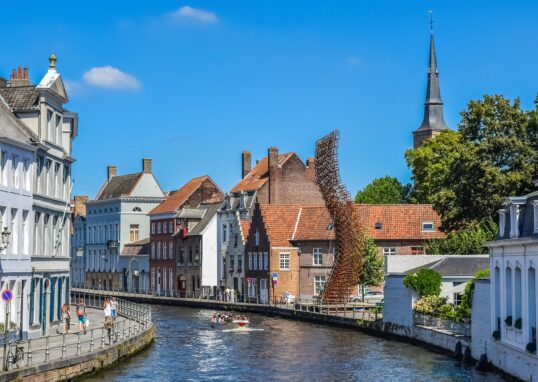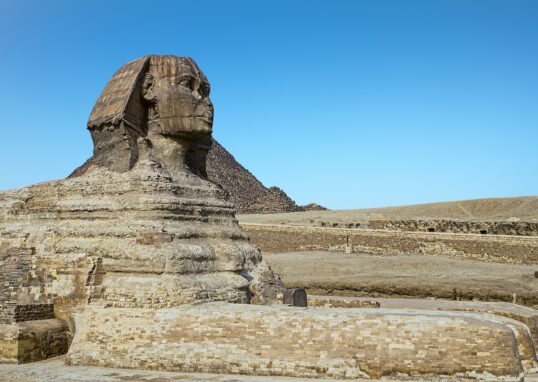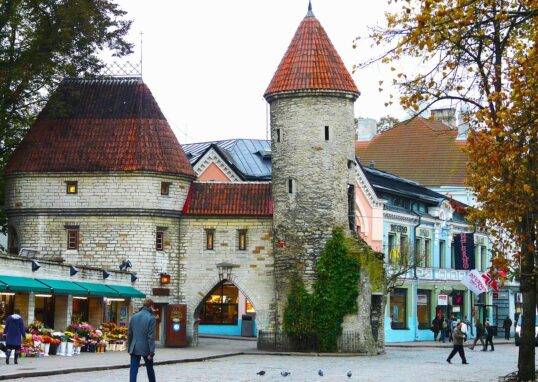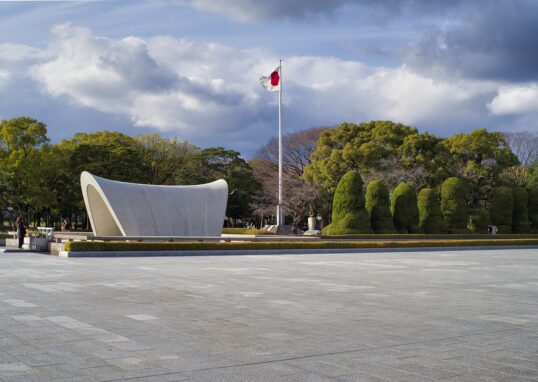
Baalbek: The City of Ancient Temples
Baalbek is one of the most awe-inspiring ancient cities in the world. It is located in Lebanon, in the Beqaa Valley. The city is famous due to its gigantic Roman temples and regal ruins. It is a UNESCO World Heritage Site and a tourist destination for visitors worldwide. Baalbek is also referred to as Heliopolis, or “City of the Sun.” In Roman times, it was one of the most magnificent temple complexes ever built. Today, it shows the durability and potential of ancient architecture. The city is full of history. It was occupied by various civilizations for over thousands of years. From the Phoenicians to the Romans, Baalbek was never any less important as a cultural and religious place. In this article, we will examine the history, temples, culture, architecture, festivals, and surroundings of Baalbek in detail.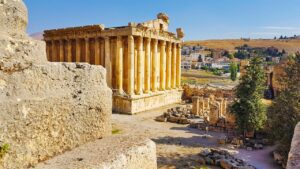
History of Baalbek
The history of Baalbek goes back more than 9,000 years. Archaeologists found traces of settlements in the Neolithic period.
Phoenician Period
The Phoenicians, ancient Mediterranean merchants, built a temple to their god Baal here. The city was given his name – Baalbek, meaning “Lord Baal of the Beqaa.”
Greek Period
Later, when the Greeks came, they gave the city the name Heliopolis. They equated the local god Baal with their sun god, Helios.
Roman Period
The Romans arrived in 64 BCE and made Baalbek one of their finest religious cities. They started building gigantic temples. The temples were for Jupiter, Venus, Bacchus, and Mercury. It took more than 200 years to finish building. Colossal stones were used, weighing more than 1,000 tons. These temples were bigger than anything else in the Roman empire.
Byzantine and Islamic Periods
After the Roman Empire declined, the temples were transformed into churches by the Byzantines. Later, during the Islamic period, mosques and fortresses were built around the ruins.
Ottoman Period
The Ottoman Empire governed Baalbek for centuries. The ruins came to be used less and less but still kept being enjoyed by tourists.
Modern Period
In the 19th and 20th centuries, European travelers examined Baalbek. Archaeologists attempted to preserve the site. In 1984, UNESCO listed Baalbek as a World Heritage Site.
The Temples of Baalbek
The most famous feature of Baalbek is its temple complex. It contains some of the largest and best-preserved Roman temples in the world.
Temple of Jupiter
The Temple of Jupiter was the central temple. It was used for Jupiter, who was the king of Roman gods.
- It used to have 54 colossal columns. Each column was 22 meters high. Now only 6 of them remain. Even in destruction, they indicate how huge and strong the temple used to be. The temple was built on a massive platform of gigantic stone blocks.
Some of them are the biggest stones ever used in building.
Temple of Bacchus
Located next to Jupiter’s temple is the Temple of Bacchus. This temple is even better preserved.
- It was dedicated to Bacchus, the god of festivity and wine. It is smaller than Jupiter’s temple but still gigantic. The decoration is rich with vine carvings, grapes, and Roman gods. Travelers can enter and see the details of Roman art.
Temple of Venus
The Temple of Venus is smaller and dainty.
- It was built with curved walls and flowing curves. It was later transformed into a church by the Byzantines. Its charm contrasts with the sheer magnitude of the other temples.
Temple of Mercury
The Temple of Mercury stood on a hill nearby. Only remains are present today. But it was another important part of the religious complex earlier.
Architecture and Engineering
The architecture of Baalbek proves Roman engineers’ craftsmanship.
- The platform of the Temple of Jupiter is made up of the Trilithon, three gigantic stone pillars. Each pillar weighs around 800 tons. The mode of transport of stones is still unknown. They use Greek, Roman, and local designs.
- They have decorations like carvings of flowers, animals, and mythical creatures. The stones were cut to an exact size, which reflects the use of superior engineering then.
Most scholars do not believe Baalbek was merely a religious complex but an exhibition of Roman power too.
Festivals in Baalbek
Baalbek is not only ancient ruins. It is also the location for one of Lebanon’s most prestigious cultural festivals: the Baalbek International Festival.
Baalbek International Festival
- Started in the 1950s, it is the most old and prestigious festival in the Middle East. It takes place every summer inside the ancient temple complex.
- It has hosted great artists such as Fairuz, Ella Fitzgerald, Sting, and Andrea Bocelli. The festival features music, theater, dance, and opera. The setting of contemporary art within ancient ruins is unforgettable.
Baalbek Today
Presently, Baalbek is a blend of ancient history and contemporary life.
- The modern city of Baalbek encircles the ruins. It is filled with markets, restaurants, and local culture. Agriculture here is very important. The Beqaa Valley is rich land that produces fruits, vegetables, and most notably grapes for wines.
- Tourism makes up a great majority of the economy. Individuals from around the globe come to see the ruins and partake in Lebanese hospitality.
Surrounding Places Near Baalbek
Baalbek is Lebanon’s most famous historical site. It is located in the Beqaa Valley, a beautiful and fertile area. The temples of Baalbek are the main draw, but the area is also extremely valuable. There are towns, villages, and natural wonders close by that offer history, culture, food, and adventure. In this article, we are going to talk about the prime surrounding places near Baalbek. We are going to talk about Zahle, Anjar, Hermel, Beqaa Valley Wineries, and the Cedars of Lebanon. Every place has a certain beauty and adds to the journey of travelers.
Zahle: The Bride of the Beqaa
Zahle is the best known of Baalbek’s surrounding towns. It is sometimes called the “Bride of the Beqaa.” It is situated on the Berdawni River and is renowned for its food and cuisine.
Food and Dining
Zahle is the gastronomic capital of the Beqaa Valley. It possesses a stretch of restaurants beside the riverside. Visitors adore eating by listening to the gurgling sound of water. The area is famous for mezze, kebabs, grilled meat, and salads of green leaves. Traditional Lebanese wine is also famous in Zahle. Great bottles are made by vineyards bordering the town. Visitors prefer meals with wine tasting.
Culture and History
Zahle has been the cultural center for ages. It has produced poets, authors, and artists for the world. The town is also renowned for its celebrations and festivals. Lady of Zahle and the Bekaa, a large statue of Virgin Mary, towers above the city. It is a large pilgrimage site. From there, the crowd also gets to see a wide view of the valley.
Why Visit
Zahle Tourists love Zahle due to its peaceful environment. It contains food, culture, and nature. The riverbank restaurants rank it among the best places to enjoy Lebanese hospitality.
Anjar: The Umayyad City
The second UNESCO World Heritage Site close to Baalbek is Anjar, an old city built by the Umayyad dynasty in the 8th century.
History and Ruins
Anjar was built during the time of Caliph Walid I. It was a trade center along the Silk Road. Its remains are toured by visitors today. The complex comprises palaces, mosques, bazaars, and baths. Architecture at Anjar has both Roman and Islamic influences. The town plan is planned with roads that meet in right angles. This is unlike most other ancient cities.
What to See
Anjar site has fine remains. One can drive along the main roads and imagine residing in the city. The Great Palace remains show the power of the rulers. The mosque and public baths demonstrate the routine life of humankind.
Why Visit Anjar?
Anjar offers a special view of the earliest Islamic period. It shows how various cultures fused with one another in the Beqaa Valley. The archaeological site is peaceful, and Anjar’s surrounding area is full of vegetation.
Hermel: Nature and History
Hermel is located to the north of Baalbek. Hermel is renowned for its natural landscape and outdoor activities. The Orontes River starts here, and the region is full of greenery.
Natural Attractions
The Orontes River is a treasure of Hermel. People come here for picnics, angling, and recreation. The river flows over fields and farms, providing a background of peace. The Pyramid of Hermel is another tourist favorite. It is an antique building in the shape of a pyramid. Its past is ambiguous, but most presume that it was built as a sepulcher for a king or a warrior.
Outdoor Adventures
Hermel is a great place for trekking and exploration. The hills and valleys around the town provide good trails. Tourists also go hunting and camping.
Why Visit Hermel?
Hermel is perfect for nature enthusiasts. It contains history combined with outdoor existence. The scenery, the pyramid, and the river make it a special place.
Beqaa Valley Wineries
Beqaa Valley is the center of Lebanese wine production. It boasts a winemaking history that dates thousands of years back. Today, it hosts a number of wineries that welcome tourists.
World-famous wineries
Chateau Ksara: Lebanon’s oldest and most famous winery. Founded by Jesuit priests in 1857. Popular red, white, and rosé wines. The wine kept in the caves underground is a favourite among tourists.
Chateau Kefraya: Another favourite winery in the valley. Winner of prize-winning wines. Vineyards all around it and one can take a guided tour. Chateau Massaya: A modern winery that combines tradition and innovation. It is known for creating quality wines and an atmosphere of spectacular beauty.
Wine Tours
Some of the wineries offer tours and tasting. Tourists hike through the vineyards, see the wine-making process, and taste some of the flavored ones. There are also meals with local food in some of the tours.
Why Visit the Wineries?
Beqaa Valley wineries are not merely wine. They are about culture, history, and terrain. They offer visitors the chance to encounter Lebanese lifestyles in an easygoing way.
The Cedars of Lebanon
Cedars of Lebanon are some of the most emblematic symbols of the country. They are the old trees that flower in the mountains around the Beqaa Valley.
History and Symbolism
Cedars are also mentioned in the Bible and were used in ancient temples and boats. The wood was greatly prized for its strength as well as its scent. The cedar tree is also present on the Lebanese flag.
The Forests
The most famous cedar forests are near Bsharri, north of Baalbek. There are some trees that are thousands of years old. People can walk among them and feel a sense of peace and being with nature. The Cedars of God nature reserve preserves these ancient cedars. It is a UNESCO World Heritage Site. The forest looks especially beautiful in winter, when it is blanketed with snow.
Outdoor Activities
Hiking and skiing are also practiced in the cedar forests. In winter, there is tourist visitation to local ski resorts. In summer, hiking trails are cool retreats from the heat of the valley.
Why Visit the Cedars?
The Cedars of Lebanon are not forests. They are a symbol of history, spirituality, and endurance. To see them lends depth to the tour of Baalbek.
How These Places Connect to Baalbek
Each of the surrounding sites contributes something different to the experience of visiting Baalbek.
- Zahle offers food, wine, and culture. Anjar offers Islamic-era history. Hermel offers nature and outdoor recreation. The wineries offer the traditions of the Beqaa Valley. The Cedars contribute religious and natural beauty. All combined give a complete experience for any visitor.
- Baalbek is famous for its temples and history. But the surrounding places contribute more wealth to the journey. Zahle, Anjar, Hermel, the Beqaa Valley vineyards, and the Cedars of Lebanon each contribute something unique. Visitors who travel to these sites will not only witness ruins but also experience food, nature, history, and the soul of Lebanon.
The tour around Baalbek is a mixture of the past and present, culture and nature, tradition and beauty. Touring Baalbek and its environs is an actual discovery.
Importance of Baalbek
Baalbek is greater than an archaeological site. It is evidence of the diversity of Lebanon’s history and culture.
- It is a reflection of the blend of many civilizations – Phoenician, Greek, Roman, Byzantine, and Islamic. It attests to the genius of ancient architects.
- It continues to inspire artists and composers by the Baalbek Festival. It connects modern Lebanon to its glorious past.
Conclusion
Baalbek is one of the globe’s most ingenious gems of the past. Its colossal temples, mysterious stones, and breathtaking valley make an indelible mark. Baalbek city is the history of millennia. Traveling to Baalbek is traveling back in time. However, the festivals and modern life affirm that Baalbek is still alive and kicking. With its surrounding towns, vineyards, and mountains, Baalbek is not only a site of ruins but also a center of culture, nature, and hospitality. No traveler to Lebanon would ever like to leave Baalbek behind. Indeed, it is the City of the Sun, glistening in history and splendor.

